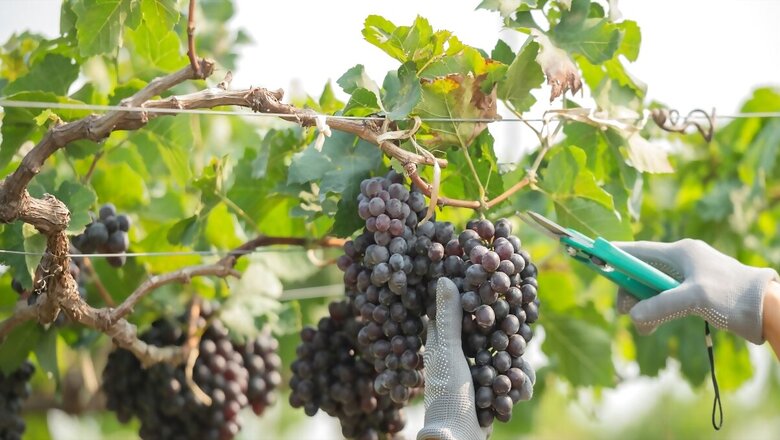
views
As India strives towards a more resilient and stable economy, the amalgamation of traditional agriculture and cutting-edge technology makes the lush vineyards and sprawling IT campuses a possibility of sustainability and operations. An eco-friendly and sustainable utopia is achievable only by driving green harvesting practices, which will usher the country into a new era of economic growth and environmental agility.
Green harvesting would lead us into a future where every harvest not only feeds the nation but also nourishes it. Green harvesting, in simpler terms, involves removing immature crops to improve the quality of the yield from the remaining produce. A straightforward example of this is the practice of thinning grape clusters by wine farmers to ensure that the remaining grapes receive more nutrients, resulting in better wine quality. Green harvesting is not just an agricultural practice; it also protects against adverse environmental impacts by incorporating technologically sound practices throughout the product’s life cycle.
The economic aspect of green harvesting is significant, as it enhances agricultural productivity with a focus on quality, thereby helping farmers increase their incomes, transforming marketability, and opening new frontiers for export opportunities. This impact creates a cascading effect within the circular economy of rural regions, in particular. It can further enhance income stability while reducing waste generation, paving the way to achieve environmental equilibrium. These efforts would lead to a world where quality drives sustainability, resulting in a booming economy.
In terms of technical stability, green harvesting incorporates sustainable designs, energy-efficient operations, and e-waste disposal management, aligning with the protection of society. The implementation of green harvesting is being advanced by several tech giants such as Infosys and Wipro. Their investments in green data centres have allowed them to reduce operational costs while fostering green infrastructure development across their sprawling campuses.
Sula Vineyards in Maharashtra is a practical example of active green harvesting processes. The adoption of such practices has enabled them to produce superior quality wine, along with achieving greater export revenues and economic growth. This growth has propelled Sula to enjoy a 26.7 per cent growth rate in revenue and a substantial 61 per cent increase in profits. This sharp upward trend has also boosted wine tourism, helping the sector achieve a 17 per cent compound annual growth rate (CAGR). Such compounded benefits indicate a promising trend of green harvesting from an economic perspective, which could help the agricultural sector grow at a more definitive pace. Sula’s success story is a testament to the power of going green.
Ironically, green harvesting in India faces many challenges. Among them, the high monetary costs associated with green harvesting pose a significant obstacle. Additionally, the lack of awareness among the masses about such agricultural practices creates substantial barriers. The government is addressing these issues by providing subsidies and incentives to alleviate the burden on farmers and even encouraging tech companies to foster long-term stability.
One of the major government initiatives in this regard is the National Mission for Sustainable Agriculture (NMSA), which focuses on providing technical and logistical support to farmers while catering to their financial needs. NMSA has been instrumental in supporting Indian farmers by helping them develop various integrated farming systems, combining crop, livestock, and fish cultures to enhance productivity. It has also aided farmers in maintaining a high level of water efficiency through improved practices.
On the other hand, the introduction of the Green Credits Program (GCP) has encouraged various stakeholders to make environmentally friendly, actionable decisions. A positive environmental activity leads to a company receiving a Green Credit certificate, which can be redeemed on a dedicated Green Credit platform to foster a more environmentally conscious market. These collaborative efforts among the government, tech sector, and farming industry are steps in the right direction toward better adoption of green practices.
In the long term, the benefits of green harvesting are substantial. It not only improves agricultural yields but also enables the sector to withstand market volatility caused by climate change. This translates to reduced operational costs and enhanced effectiveness of agricultural produce. The adoption of green harvesting also supports the Sustainable Development Goals (SDGs), particularly those related to responsible consumption and production, climate action, and economic growth. Emerging trends in technology, such as artificial intelligence (AI) and the Internet of Things (IoT), play a pivotal role in bolstering green agriculture. In the tech sector, advancements in renewable energy and circular economy principles can drive the next wave of sustainability.
Overall, it must be understood that green harvesting is not just an agricultural or technological practice but a pragmatic shift towards a more sustainable and stable future. By embracing these practices, India is poised to achieve a green equilibrium in terms of sustainability and development. As we stand on the brink of a Green Revolution 2.0, the time to act is now! Let’s harness the power of green harvesting to cultivate not just crops and technologies, but a thriving, resilient, and sustainable India.
Megha Jain is Assistant Professor, Shyam Lal College, University of Delhi/ Visiting Fellow, Pahle India Foundation; Naman Mishra is Postgraduate Researcher, FS University, Shikohabad, India. Views expressed in the above piece are personal and solely those of the author. They do not necessarily reflect News18’s views.




















Comments
0 comment